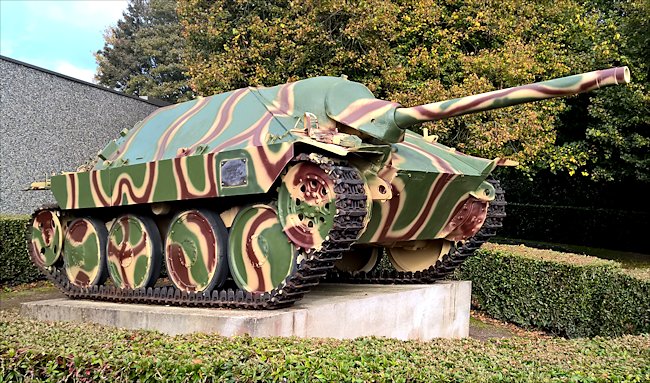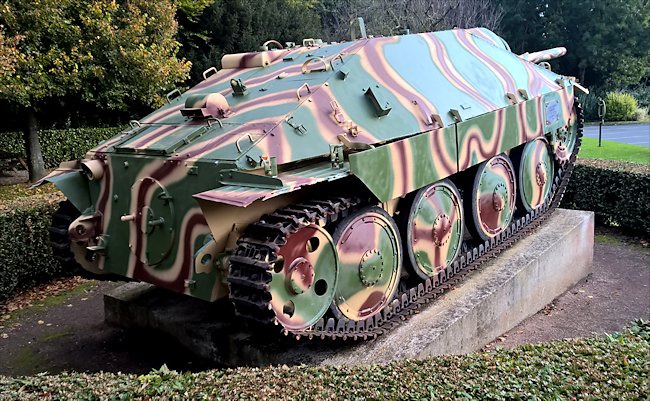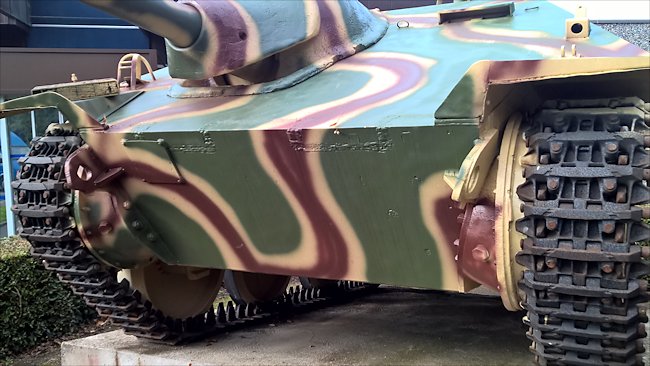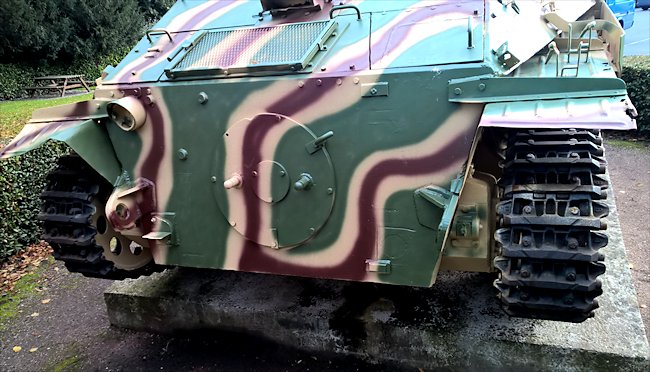Bayeux Hetzer G-13 Tank Destroyer
The German Jagdpanzer 38 Hetzer tank destroyer did not take part in the defence of Normandy. It first entered service on the Eastern Front in July 1944. It is strange that the Bayeux Memorial Museum of the Battle of Normandy decided to place a Hetzer outside the museum.

Bayeux Memorial Museum of the Battle of Normandy Hetzer G-13 Tank Destroyer
Location
The four tanks at the Bayeux Memorial Museum of the Battle of Normandy are exhibited outside the Museum near the car park. The British and Commonwealth Cemetery is on the other side of the road. It holds the graves of 4,000 men. Both the Military Cemetery and the Museum are on the road called Boulevard Fabian Ware in Bayeux.
This road is part of the ring road around Bayeux that was built by the British Royal Engineers in June to enable the troops, tanks and supply vehicles to get to the battlefront quickly and avoid having to struggle through the narrow streets of the city of Bayeux. Be aware that the museum closes for lunch. You can still see the tanks as they are outside even if the museum is closed.

Musee de la Bataille de Normandie a Bayeux Hetzer G-13 Tank Destroyer
Specification
G13 muzzle brake removed to make it look more like the WW2 Hetzer tank destroyer configuration. If you look at the end of the gun barrel you can still see the screw thread. Its main gun is a 75 mm Pak 39 L/48. The 7.92 mm MG 34 machinegun was not fitted in the front hull like most tanks. It was attached to the top of vehicle.
It was powered by a Praga EPA AC 2800 6-cylinder 7.8 litres water-cooled petrol engine that produced 159 hp. It had a maximum road speed of 42 km/h (26 mph). The engine was also fitted with a pre-heater for use in cold climates as standard following lessons learned from time spent on the Eastern Front. It had an operational range of 177 km (110 miles). It required a crew of 4; Commander, gunner, driver and loader. It was based on an extended Czechoslovakian built Panzer 38(t) tank chassis.

The sloped armour on the Hetzer G-13 Tank Destroyer helped deflect incoming enemy shells
The WW2 Hetzer tank destroyer
The Jagdpanzer (tank hunter) was the generic term for a series of self-propelled guns built by the Germans during the Second World War. They were turret less tanks fitted with fairly large calibre anti-tank guns in well-sloped armoured superstructures.
They were designed to be used in a 'hull down' well-camouflaged defensive position and ambush enemy tanks, vehicles and troop. They would then move and change location. The German Jagdpanzers were capable of engaging and defeating nearly all the armoured vehicles used by the Allies on the Western Front. Some of the later Russian heavily armoured tanks on the Eastern Front were a bit more problematic.
Compared to a tank they lacked sophistication which meant that more could be built in a shorter space of time and without the need for the same amount of resources and materials required to build more complex tanks with revolving turrets.
The Czech designed and built Pz.Kpfw. 38(t) tank that formed the basis for the Hetzer in 1944 was now obsolete. It had been an effective tank during the invasion of Poland, France and Russia but was out classed by the Russian T34 and the American Sherman tank.

To start the Hetzer G-13 Tank Destroyer in cold weather the crew inserted a crank handle into the rear of the vehicle
Rather than just scraping the old tanks a number of the chassis were built into self-propelled artillery and anti-tank guns like the Marder III. It was therefore a logical progression when it was decided to use the hull and running gear of the Pz.Kpfw. 38(t) once again as the basis for the new light Jagdpanzer in late 1943.
The German and Czech engineers made a decision to try and keep 80% of the original panzer 38(t) tank in order to reduce the amount of time need to tool up for the new Jagdpanzer 38 Hetzer tank destroyer, while at the same time keeping maximum commonality for spare parts.
The new Hetzer had good sloped frontal armour, a low silhouette and was armed with the tried and tested powerful 75mm PaK 39 (L/48) anti-tank gun. The basic 38(t) chassis was widened to provide more interior space, with the suspension and running gear remaining largely unchanged.
The front glacis plate was 60mm thick and angled at 600 to give maximum ballistic protection without the negative effect of additional weight. It had a cast shaped mantlet protecting the 75mm gun where it entered the glacis plate. The Hetzer's side armour to the superstructure was just 20mm in thickness, but angled at 400 to increase the level of protection, a lesson learned by the German designers early on when studying the then new Soviet T-34 tank with its well-sloped armour.
The rear of the vehicle was less well protected, partly to save weight, and partly due to the fact that it was hoped that the enemy would rarely see the rear of the hull given that the vehicle crew were taught that their best chance of survival was to only present the front of the Hetzer to the enemy. The rear armour on the Hetzer was only 8mm thick and the floor was just 10mm thick.
The post WW2 G13 Hetzer
In 1946 the Swiss Army placed an order with the new Czechoslovakian Government for 158 Hetzer tank destroyers. They would be come known as the G-13 Hetzer. When they finished operational service with the Swiss Army they were offered for sale. Military collectors and Museums purchased them and passed them off as WW2 German Hetzer Jagdpanzers just like the one at the Bayeux Memorial Museum of the Battle of Normandy.
How do you tell the difference between a WW2 or Swiss G-13 Hetzer?
Outwardly there is very little difference between the G-13 Hetzer and WW2 Hetzer. A muzzle brake was fitted to the G13 Swiss vehicles to help reduce recoil and increase the working life of the gun barrel. Even if the muzzle brake has been removed from a G-13 Hetzer to make it look more like a WW2 German Hetzer the screw thread is normally still visible as in the case of the G-13 Swiss Hetzer in Bayeux. Some Museums are sneaky and replace the gun barrel of the G13 Hetzer with a barrel that does not have a screw thread to make it look like a genuine example of a wartime Hetzer.
Other differences are harder to spot. The G-13 Hetzer Commander and loader changed positions. A telephone for communication with following infantry was fitted to the rear of the tank destroyer. The petrol engine was replaced with a diesel engine in swiss service. The main gun was the 75mm StuK-40 L/48 of the german Sturmgeschuetz and not the original used 75mm Pak-39.
D-Day 1944 books

